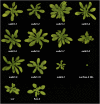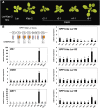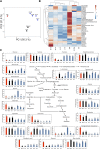NLR Mutations Suppressing Immune Hybrid Incompatibility and Their Effects on Disease Resistance
- PMID: 29794019
- PMCID: PMC6052992
- DOI: 10.1104/pp.18.00462
NLR Mutations Suppressing Immune Hybrid Incompatibility and Their Effects on Disease Resistance
Abstract
Genetic divergence between populations can lead to reproductive isolation. Hybrid incompatibilities (HI) represent intermediate points along a continuum toward speciation. In plants, genetic variation in disease resistance (R) genes underlies several cases of HI. The progeny of a cross between Arabidopsis (Arabidopsis thaliana) accessions Landsberg erecta (Ler, Poland) and Kashmir2 (Kas2, central Asia) exhibits immune-related HI. This incompatibility is due to a genetic interaction between a cluster of eight TNL (TOLL/INTERLEUKIN1 RECEPTOR-NUCLEOTIDE BINDING-LEU RICH REPEAT) RPP1 (RECOGNITION OF PERONOSPORA PARASITICA1)-like genes (R1-R8) from Ler and central Asian alleles of a Strubbelig-family receptor-like kinase (SRF3) from Kas2. In characterizing mutants altered in Ler/Kas2 HI, we mapped multiple mutations to the RPP1-like Ler locus. Analysis of these suppressor of Ler/Kas2 incompatibility (sulki) mutants reveals complex, additive and epistatic interactions underlying RPP1-like Ler locus activity. The effects of these mutations were measured on basal defense, global gene expression, primary metabolism, and disease resistance to a local Hyaloperonospora arabidopsidis isolate (Hpa Gw) collected from Gorzów (Gw), where the Landsberg accession originated. Gene expression sectors and metabolic hallmarks identified for HI are both dependent and independent of RPP1-like Ler members. We establish that mutations suppressing immune-related Ler/Kas2 HI do not compromise resistance to Hpa Gw. QTL mapping analysis of Hpa Gw resistance point to RPP7 as the causal locus. This work provides insight into the complex genetic architecture of the RPP1-like Ler locus and immune-related HI in Arabidopsis and into the contributions of RPP1-like genes to HI and defense.
© 2018 American Society of Plant Biologists. All rights reserved.
Figures









Similar articles
-
Analysis of a plant complex resistance gene locus underlying immune-related hybrid incompatibility and its occurrence in nature.PLoS Genet. 2014 Dec 11;10(12):e1004848. doi: 10.1371/journal.pgen.1004848. eCollection 2014 Dec. PLoS Genet. 2014. PMID: 25503786 Free PMC article.
-
Arabidopsis thaliana DM2h (R8) within the Landsberg RPP1-like Resistance Locus Underlies Three Different Cases of EDS1-Conditioned Autoimmunity.PLoS Genet. 2016 Apr 15;12(4):e1005990. doi: 10.1371/journal.pgen.1005990. eCollection 2016 Apr. PLoS Genet. 2016. PMID: 27082651 Free PMC article.
-
Natural variation at Strubbelig Receptor Kinase 3 drives immune-triggered incompatibilities between Arabidopsis thaliana accessions.Nat Genet. 2010 Dec;42(12):1135-9. doi: 10.1038/ng.704. Epub 2010 Oct 31. Nat Genet. 2010. PMID: 21037570
-
Effector recognition and activation of the Arabidopsis thaliana NLR innate immune receptors.Cold Spring Harb Symp Quant Biol. 2012;77:249-57. doi: 10.1101/sqb.2012.77.014860. Epub 2012 Nov 21. Cold Spring Harb Symp Quant Biol. 2012. PMID: 23174767 Review.
-
Robust self-incompatibility in the absence of a functional ARC1 gene in Arabidopsis thaliana.Plant Cell. 2014 Oct;26(10):3838-41. doi: 10.1105/tpc.114.129387. Epub 2014 Oct 21. Plant Cell. 2014. PMID: 25336507 Free PMC article. Review.
Cited by
-
Unraveling the Diverse Roles of Neglected Genes Containing Domains of Unknown Function (DUFs): Progress and Perspective.Int J Mol Sci. 2023 Feb 20;24(4):4187. doi: 10.3390/ijms24044187. Int J Mol Sci. 2023. PMID: 36835600 Free PMC article. Review.
-
NLR receptors in plant immunity: making sense of the alphabet soup.EMBO Rep. 2023 Oct 9;24(10):e57495. doi: 10.15252/embr.202357495. Epub 2023 Aug 21. EMBO Rep. 2023. PMID: 37602936 Free PMC article. Review.
-
Ammonium and nitric oxide condition the establishment of Arabidopsis Ler/Kas-2 immune-related hybrid incompatibility.Planta. 2022 Sep 10;256(4):76. doi: 10.1007/s00425-022-03990-4. Planta. 2022. PMID: 36087170 Free PMC article.
-
A Truncated Singleton NLR Causes Hybrid Necrosis in Arabidopsis thaliana.Mol Biol Evol. 2021 Jan 23;38(2):557-574. doi: 10.1093/molbev/msaa245. Mol Biol Evol. 2021. PMID: 32966577 Free PMC article.
-
Plant NLRs with Integrated Domains: Unity Makes Strength.Plant Physiol. 2019 Apr;179(4):1227-1235. doi: 10.1104/pp.18.01134. Epub 2018 Dec 10. Plant Physiol. 2019. PMID: 30530739 Free PMC article. Review.
References
-
- Alcázar R, García AV, Kronholm I, de Meaux J, Koornneef M, Parker JE, Reymond M (2010) Natural variation at Strubbelig Receptor Kinase 3 drives immune-triggered incompatibilities between Arabidopsis thaliana accessions. Nat Genet 42: 1135–1139 - PubMed
-
- Alcázar R, Pecinka A, Aarts MGM, Fransz PF, Koornneef M (2012) Signals of speciation within Arabidopsis thaliana in comparison with its relatives. Curr Opin Plant Biol 15: 205–211 - PubMed
Publication types
MeSH terms
Substances
LinkOut - more resources
Full Text Sources
Other Literature Sources
Research Materials

